Recent Water Damage Posts
Understanding Water Loss and the Role of Air Movers in Water Damage Restoration
6/20/2024 (Permalink)
 Air Movers for a Large Commercial Loss, pre-setup.
Air Movers for a Large Commercial Loss, pre-setup.
Water damage is a common yet devastating problem that can strike homes and businesses at any time. Whether due to a natural disaster like a flood, a plumbing mishap, or an appliance failure, water intrusion can cause significant property damage and pose serious health risks. Effective water damage restoration is crucial to mitigate these effects, and one of the most critical tools in this process is the air mover.
What is Water Loss?
Water loss refers to the unwanted presence of water in areas where it can cause damage to structures, furnishings, and personal belongings. The severity of water loss can vary, ranging from minor leaks to major flooding events. Understanding the category and class of water loss is essential for determining the appropriate restoration approach.
- Category 1: Clean water from sources like broken water supply lines or overflowing sinks. This type of water poses no substantial risk to health.
- Category 2: Gray water, which can cause illness if ingested. This category includes water from washing machines, dishwashers, or toilet overflows with some contaminants.
- Category 3: Black water, which is highly contaminated and can cause severe illness or death if ingested. This includes sewage, floodwater, or any water containing fecal matter.
Water loss is also classified by the extent of the damage:
- Class 1: Minimal water absorption affecting part of a room or area.
- Class 2: Significant water absorption affecting an entire room, including walls and carpeting.
- Class 3: Greatest amount of water absorption, typically from overhead sources, saturating the ceiling, walls, and floor.
- Class 4: Specialty drying situations with deeply saturated materials such as hardwood, plaster, and concrete.
The Critical Role of Air Movers
Air movers, also known as industrial blowers or fans, are essential tools in the water damage restoration process. They play a vital role in drying out affected areas quickly and efficiently, helping to prevent further damage such as mold growth and structural weakening.
How Air Movers Work
Air movers work by creating a high-velocity airflow over and around wet surfaces. This increased air circulation enhances evaporation, significantly speeding up the drying process. They are strategically placed to ensure that the maximum amount of air reaches all affected areas, including hard-to-reach spaces like under carpets and inside walls.
Types of Air Movers
There are several types of air movers used in water damage restoration, each suited for different situations:
- Centrifugal Air Movers: These are compact and powerful, ideal for focused drying. They are commonly used for drying carpets, floors, and walls.
- Axial Air Movers: These produce a large volume of airflow and are used to dry larger areas. They are particularly effective in drying out entire rooms and large spaces.
- Low-Profile Air Movers: Designed to fit in tight spaces, these air movers are perfect for drying under cabinets, crawl spaces, and other confined areas.
Benefits of Using Air Movers
- Accelerated Drying Time: By promoting rapid evaporation, air movers drastically reduce the drying time, minimizing the potential for mold growth and structural damage.
- Energy Efficiency: Modern air movers are designed to be energy-efficient, ensuring that the drying process does not lead to exorbitant energy costs.
- Versatility: Air movers can be used in various scenarios, from small residential water losses to large-scale commercial water damage situations.
- Mold Prevention: Quick and thorough drying prevents mold spores from settling and growing, protecting indoor air quality and health.
SERVPRO's Expertise in Water Damage Restoration
At SERVPRO, we understand the critical importance of a swift and efficient response to water loss incidents. Our team of highly trained professionals is equipped with the latest air movers and other advanced drying equipment to ensure comprehensive restoration. We follow a meticulous process that includes:
- Assessment: Identifying the category and class of water loss to determine the appropriate restoration strategy.
- Water Extraction: Removing standing water using powerful pumps and vacuums.
- Drying and Dehumidification: Utilizing air movers and dehumidifiers to eliminate moisture from all affected areas.
- Cleaning and Sanitizing: Thoroughly cleaning and sanitizing surfaces to remove contaminants and prevent mold growth.
- Restoration: Repairing and restoring damaged areas to their preloss condition.
Conclusion
Water damage can be a challenging ordeal, but with the right tools and expertise, it is possible to restore your property efficiently and effectively. Air movers play an indispensable role in the drying process, ensuring quick recovery and minimizing long-term damage. Trust SERVPRO for all your water damage restoration needs – we are here to make it "Like it never even happened."
For more information or immediate assistance, contact SERVPRO today. Our team is available 24/7 to provide expert water damage restoration services.
How To Prevent Water Damage
12/22/2021 (Permalink)
 Flood cuts after water damage in a home in Gladstone, MO.
Flood cuts after water damage in a home in Gladstone, MO.
How To Prevent Water Damage At a Residence
Maintenance is the best way to prevent water damage. A number of appliances and systems rely on water in the home in order to function. Learn more about how to prevent damage at a residence in Gladstone, MO.
Appliances
A number of appliances rely on water in order to function. This machinery includes:
- Dishwashers
- Washing machines
- Water heaters
Connections or hoses may fail and lead to leaks. It is a good idea to closely monitor these machines and have them regularly serviced for maintenance rather than just for repairs.
HVAC System
The HVAC system in a residence relies on water, particularly when cooling. Several common causes of leaks include:
- A dirty coil
- An icy coil
- A damaged overflow drain pan
- Clogged drain lines
Regular maintenance can also help to prevent HVAC leaks. Schedule a yearly inspection and cleaning to reduce the risk of water damage.
Plumbing
Plumbing is the major source of water in the home, and therefore one of the most common causes of damage. A homeowner should know the age and condition of pipes. Look out for any signs of:
- Leaks
- Sewage backups
- Malfunctioning toilets
- Corroded supply lines
If you have exposed pipes, it is a good idea to add insulation. You can also drip a faucet when temperatures dip below freezing to relieve the pressure that can lead to pipe bursts. Any incidents will necessitate broken pipe repair and water damage cleanup.
These appliances and systems are the most likely sources of damage due to water in the home. Even if you take preventative measures such as performing regular maintenance, an accident may still occur. In these instances, it is important to quickly arrange for pipe cleanup. Appliance specialists or plumbers can fix the cause of damage, and mitigation professionals can remove water and promote drying. These measures are necessary to keep damage from worsening or resulting in secondary issues, such as mold.
How To Fix a Flooded Basement
11/28/2021 (Permalink)
 A flooded basement in Liberty, MO.
A flooded basement in Liberty, MO.
How to Repair a Flooded Basement
Despite your insurance coverage, a basement flood may be a terrible thing that can leave homeowners in complete disarray. Thankfully, the cleanup process can be straightforward and manageable. Follow the steps below to restore and protect your home from current and future flood concerns.
1. Pause and Be Safe
While it may be instinct to rush into a flooded basement and salvage everything as quickly as you can, you may want to slow down and take in your surroundings. Floodwater presents both slip and fall and shock hazards. Before entering the damaged area, turn off the electricity and put on protective clothing, like rubber boots and gloves.
2. Drain and Tear Out
Cleanup from a basement flood often requires the removal of excess water and the tear out of drywall and insulation, depending on the extent of the damage. You can rent a variety of pumps, either submersible or above ground, to quickly remove water. When removing drywall and insulation, consider tearing away material at least 20 inches above the water line to prevent any mold growth.
3. Discard and Salvage
While many items may have sentimental value, be aware that porous objects like clothing and paper can carry bacteria and produce mold after a flood. Additionally, any appliances that were touched by the water may require inspection by a professional in Liberty, MO, before further use. The main thing is to remove any sign of contamination.
4. Plan and Prepare
After a flood, you can install backflow valves, and sump pumps to help protect against basement flood reoccurrence. You may also want to inspect the grade of your landscaping as well to ensure that your homes drainage systems are in peak shape. Installation of preventative measures and routine maintenance can help prevent this type of disaster from happening again.
A basement flood can be a damaging and upsetting event. From the lost memories to the worrisome costs, a flood can be detrimental to homeowners. However, by following the above steps and preparing for potential future risks, homeowners can begin to ease even their worst concerns.
Don’t Flush Your Savings down the Drain: Understanding Sewer Backups and Homeowner Claims
9/13/2021 (Permalink)
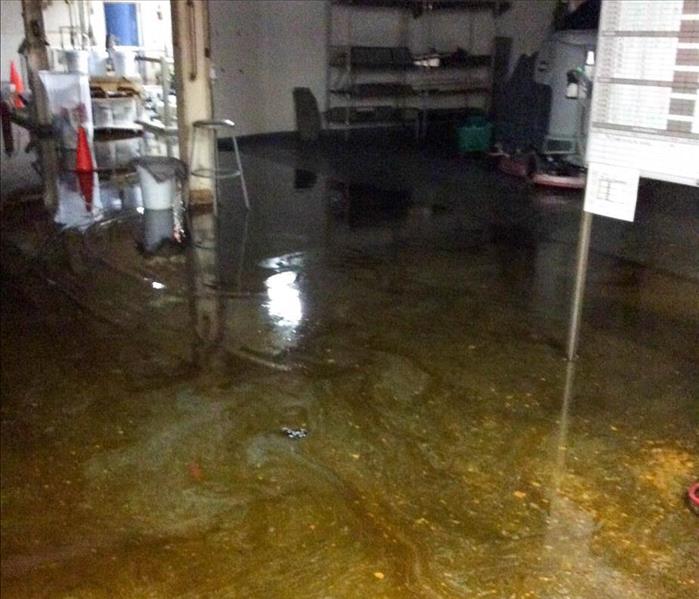 Nobody wants to experience a sewer backup, but it is necessary to understand the basics and to know what your homeowner policy covers.
Nobody wants to experience a sewer backup, but it is necessary to understand the basics and to know what your homeowner policy covers.
The rainy season in flood zones can produce a lot of anxiety for homeowners. Especially, when you consider that basic home insurance policies may not cover damage incurred by a sewer backup, meaning that if sewage starts spilling over your toilet, contaminating and damaging your home, you may be left footing the bill; however, even if your policy covers backups, there are still some things that you should understand.
1. Understand the Potential Causes of a Backup
A sewage backup typically doesn’t happen without reason, and sometimes these reasons are things you have control over. For instance, one of the main causes of a backup is a blockage in the line due to roots. Shrubs, bushes, trees can produce roots that are dense enough to break through your sewer lines, clogging the pipes and ultimately causing a backup.
2. Understand Common Prevention Tactics
Understanding how a sewer backup occurs enables you to perform preventative maintenance. For instance, you can ensure that no trees or shrubs are encroaching in areas where the waste lines run. You can also ensure that you dispose of things like grease and paper properly, and you can install a backwater prevention valve.
3. Understand the Cleanup Process
In the unfortunate event that you experience a sewage backup, you should familiarize yourself with the cleanup process, which includes a lot of wet vacuuming, mopping, disinfecting, and any other contaminant removal. However, it may be a good idea to call in restoration specialists to assist you in this process, and it will likely be a requirement by any insurance coverage you may have.
4. Understand the Process of Filing a Claim
Most insurance companies expect certain things when clients file claims. For instance, you should have before and after photos of the damaged area. You should itemize a list of property that was damaged or lost. And, you should contact your insurance representative immediately. It is also a good idea to save any receipts related to any restoration work.
Nobody wants to experience a sewer backup, but if you are in Gladstone, MO, it is necessary to understand the basics and to know what your homeowner policy covers.
What You Should Know About Basement Flooding
8/24/2021 (Permalink)
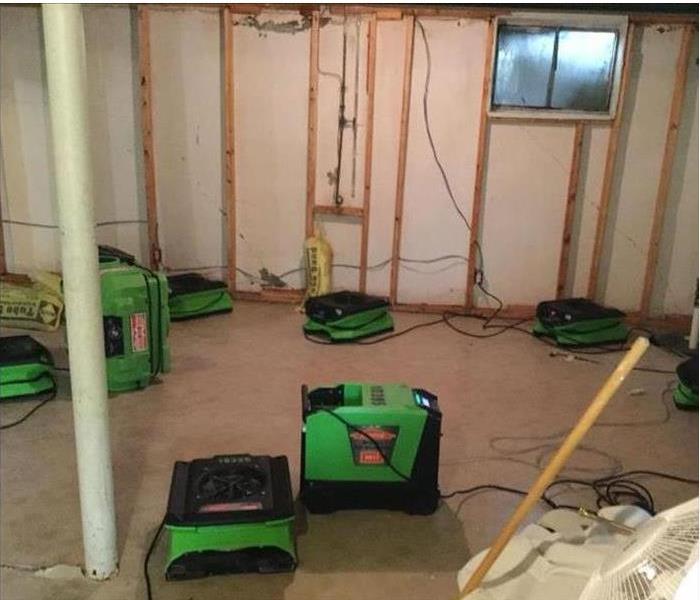 This basement in a home in Smithville, MO, experienced flood damage after recent heavy rains.
This basement in a home in Smithville, MO, experienced flood damage after recent heavy rains.
What You Should Be Aware Of Regarding Basement Flooding
If you have a basement in Kansas City, MO, you know minor foundation leaks, rain water, and broken pipes can cause flooding. As maddening as it may be, you are not alone. Insurance companies report that home flood waters are the number one disaster reported in America. But that doesn’t help when you are standing in six inches of water on brand new soaking wet carpet. You need answers about where the water came from and how to keep it from happening again.
Finding the Cause
You don’t have to live near a swollen river to find standing water all over the basement. Since water moves from high ground to low, any water source above the basement floor could be the problem. Rain, broken pipes, ground water, or even a forgotten irrigation system can all flood your home with unwanted water. It could also be a broken sump pump or a sewer problem.
Calling for Help
Removing the flooding water is only the beginning of the property clean up. Depending on the amount of water that seeped into the foundation of your home, the walls, and earth surrounding the house, it may take quite a while to restore your home. Additionally, there are three types of flood water, and each has a different method necessary for cleanup. Calling a disaster restoration specialist to identify the basement flood water can save you time and money in repairs. The restoration team can also document the steps taken in restoring your home, which can help prove your claim with the insurance company.
Dealing With Repairs
Contamination and mold spores are common issues after a flood. The restoration team can make sure the area is properly dehumidified, ventilated, and disinfected. Contractors can assess foundation, wall, and flooring damage. The actual repairs may take months.
Flooding water can be as easy to fix as a pipe repair or as difficult deal with as a broken levy. No matter what the cause, knowing who to call for help, and how to protect yourself, can help you deal quickly, and efficiently with the basement flood water in Kansas City, MO.
3 Sources of Basement Flooding
7/15/2021 (Permalink)
 Flooded basement in Liberty MO.
Flooded basement in Liberty MO.
Four Potential Causes of Flooding
When you bought or built your home with a basement in Liberty, MO, you may not have considered the different ways it could flood. A basement flood can happen from any side, including the floor, walls or ceiling. Here are four potential causes of flooding in your basement and tips on how to fix them.
1. Clogged Sewer Lines
Most clogged sewer lines are out of your control. Heavy rain or debris in municipal lines can cause the sewer lines in your house to back up, and the lower levels tend to be affected first. If sewage backs up into your basement, you must hire water restoration specialists to remedy the problem, as you do not need to handle contaminated water. They can dry and clean your basement effectively.
2. Storm Water
During regular rainstorms, your home's drainage system is probably sufficient to keep floodwaters away from your basement. Heavy flooding around your home, however, can trickle in from the place where the foundation meets your exterior walls or through cracks in the foundation itself. A drain system connected to a sump pump can help you with this problem, but it's still a good idea to have professionals make sure the area is clean and dry.
3. Pipe Problems
If a pipe bursts anywhere above your basement, it is possible for the resulting flood to end up in the basement through the ceiling or the walls. Turn off the water source to the pipe as soon as you discover the problem, and call professionals who specialize in pipe repair. They can fix the pipe and replace the damage the leak caused. A quick response is the best way to keep this problem from getting worse.
Flooding in your basement can occur from several sources. It is a good idea to take precautions to prevent it, but it's also important to know whom to call and how to fix it when a basement flood does occur.
3 FAQs About Water in Your Basement and Insurance
3/11/2021 (Permalink)
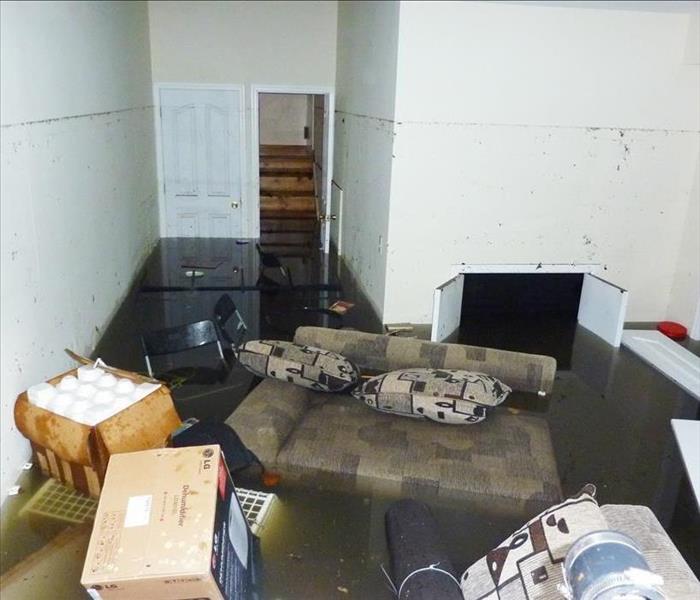 A flooded basement can occur in any home.
A flooded basement can occur in any home.
What Is Covered By Your Insurance?
The last thing you want to experience is a basement flood, but you still need to be prepared for one. That means understanding what your homeowner's insurance will cover. Here are some frequently asked questions about water sources in your basement and your insurance company's response.
1. Is a Pipe Burst Covered?
Generally, a basement flood caused by a burst pipe falls under the sudden and accidental clause in your policy. This means your insurance will pay for water remediation professionals to dry out your home and fix the damaged flooring and walls. Additionally, your insurance coverage will typically pay for any damage in your basement if you live in a duplex and your neighbor's pipe bursts.
2. Is Damage From a Storm Covered?
Damage that comes from factors outside of your home is another thing. A standard homeowner's insurance policy typically does not cover damage from natural disasters, including hurricanes, thunderstorms, or blizzards. However, you can get a separate flood insurance policy to protect against this type of event. This can be added to your homeowner's insurance or purchased as a single option through another company.
Although they can be crucial, very few homeowners have flood insurance policies. Even though mortgage lenders only require flood insurance policies in high-risk areas, it is a good idea to have this no matter where you live. After all, flooding can occur anywhere.
3. Is Groundwater Seepage Covered?
Sometimes, a basement flood can be caused by groundwater seeping through the cracks in the foundation of your home in Liberty, MO. The damage is generally not covered in these cases. This is because regular maintenance can often prevent groundwater seepage. Be sure to have your foundation inspected regularly and perform any recommended chores.
Since a flooded basement can occur in any home, it is important to understand what is covered by your insurance company. These frequently asked questions will give you a head start so you can find out what your policy covers.
What Is Category Three Water Damage?
2/16/2021 (Permalink)
 Black water's toxicity means that any affected furniture or flooring must be removed.
Black water's toxicity means that any affected furniture or flooring must be removed.
If your commercial building in Kansas City, MO has experienced a flood, you may have many questions. It's important to know what kind of floodwater you're dealing with as you begin the restoration process. There are three types of water damage, classified as Category One, Category Two, or Category Three. Here is some information about Category Three water damage, also known as black water.
Category Three Water Sources
Category Three water is the most extreme form of water damage. In order for water to be considered Category Three, it must be contaminated with toxins such as bacteria, chemicals, or sewage. Category Three or black water sources include:
- water from a rising outdoor water source,
- such as a lake or river
- a sewage backup
- a toilet overflow that contains feces
- water from a natural disaster, such as flood water
Another way you can get Category Three water is by leaving Category Two water untreated for more than two days.
Safety Precautions
Since black water is considered the most extreme form of contamination, it is important to take the correct precautions when dealing with Category Three water. If possible, avoiding exposure to Category Three water is the best way to stay safe. However, there are times when you must enter your commercial building. In this case, be sure to wear the proper protective equipment, including waterproof gloves, rubber boots, and a face shield. It's also important not to attempt to clean up the water, and instead call in a professional flood restoration company. A clean-up crew will bring the specialized equipment and tools needed to safely clean up black water.
Clean-up Procedures
Call in a professional restoration company as soon as possible. A clean-up crew will bring the specialized equipment and tools needed to safely clean up black water and begin the restoration process. Black water's toxicity means that any affected furniture or flooring must be removed and your building will be cleaned with biocides to kill any bacteria.
Category Three flood water can be damaging to your commercial building if not dealt with quickly. Call in a professional water restoration company as soon as possible can help keep your employees and building safe.
Why Does a Toilet Leak When Flushed?
1/3/2021 (Permalink)
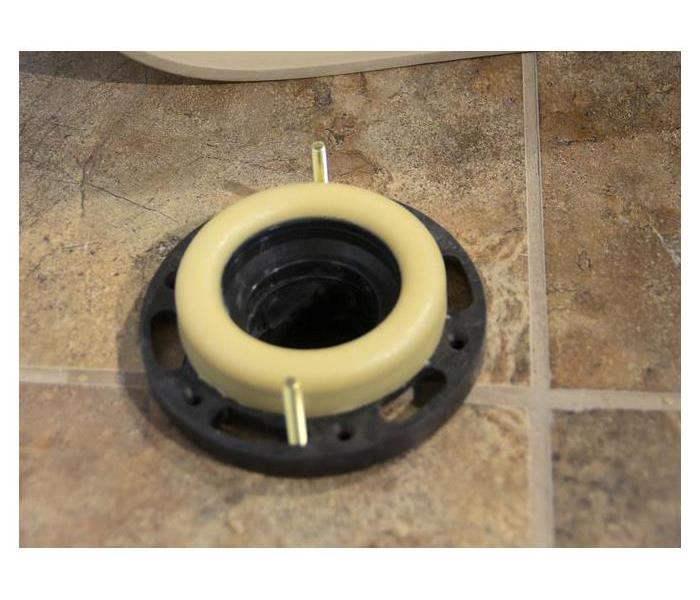 Replacing a wax ring on a leaking toilet isn't difficult
Replacing a wax ring on a leaking toilet isn't difficult
Top Reasons Why a Toilet Leaks From The Base
If you find that your toilet is leaking from the base when you flush, there are a couple of common reasons. A leaking toilet must be attended to quickly before water begins to damage the flooring. Make sure to call a water damage repair service right away if you discover water damage in your Liberty, MO, bathroom.
1. Wax Ring Issues
When the seal cracks on the wax ring, water begins to puddle around the base of the toilet. If the person who installed the toilet caulked around it quite heavily, the water may not be leaking visibly, but it could still be damaging the subflooring. An unpleasant odor will usually indicate a broken wax ring seal even if it isn't visible on the surface.
Replacing a wax ring on a leaking toilet isn't difficult.
At the shutoff valve, turn the water off to avoid a bathroom leak.
After removing the lid of the tank, hold the handle down and drain the water from the tank. Scoop up any remaining water.
Loosen the compression nut from the shutoff valve to disconnect the tube. Remove the closet bolt caps and nuts.
Carefully rock the toilet back and forth at the bowl's rim to break the seal and lift the toilet from the floor.
Scrape away the old wax ring.
Position the new wax ring on the toilet flange and set the toilet down. Make sure the wax ring gets a good seal by pressing down while rocking the toilet gently.
2. Loosened Bolts
If the bolts on each side of the toilet aren't tightened, they can cause a leak. You'll see that the bolts are covered by caps. Pop off the caps using a screwdriver and tighten the bolts with a wrench.
Protect your bathroom from water damage by fixing that leaking toilet right away.
What Swelling Wood Could Mean for Your Home
11/20/2020 (Permalink)
 Finding swelling wood means you have structural damage
Finding swelling wood means you have structural damage
What Swelling Wood Could Mean for Your Home
If you find swelling wood around the water dispensing and draining areas of your home, such as bathrooms and kitchens, it is best to check for a leak. Wood is highly porous and will absorb water easily, making it especially susceptible to water and mold damage. The parts of your home that can become swollen due to leaks include:
- Ceilings
- Cabinets
- Walls
- Floors
Finding Swollen Wood Means You May Have Structural Damage
Most homes in Kansas City, MO, are made up of a wooden structure covered with drywall or wooden planks on the ceilings and walls. It is difficult to spot damage to the structural wooden planks because they are hidden behind the ceilings and walls. If you spot a water stain on either, it is likely that you also have swelling wood in the structure of your home. It is important to fix this right away because if wooden planks remain damp, the water damage will attract mold and cause them to deteriorate. Leaks often develop around water supply lines that connect to sinks, washing machines, and toilets. Your plumbing system can also become worn and develop pipe tears, or break at the joints. This can lead to burst pipes and a flooded home. Upon noticing any leaks or worn pipes, call a plumber right away for water pipe repair to prevent severe water damages.
Contact a Restoration Service
Some wooden surfaces can be renewed through a process called water damage restoration. A company that provides this type of service will assess the damage, extract the water, and dehumidify the wood with professional tools to restore the wood. This is a great service to fix drywall and real wood, but cabinets and subflooring will need to be replaced.
If you have noticed swelling wood or ceiling and wall stains in your home, call a water damage restoration service to fix it. This will prevent the moist wood from developing mold and deteriorating, saving you the costs of unexpected repairs.
What Causes Flooded Basements and What Should Be Done After One Happens?
10/9/2020 (Permalink)
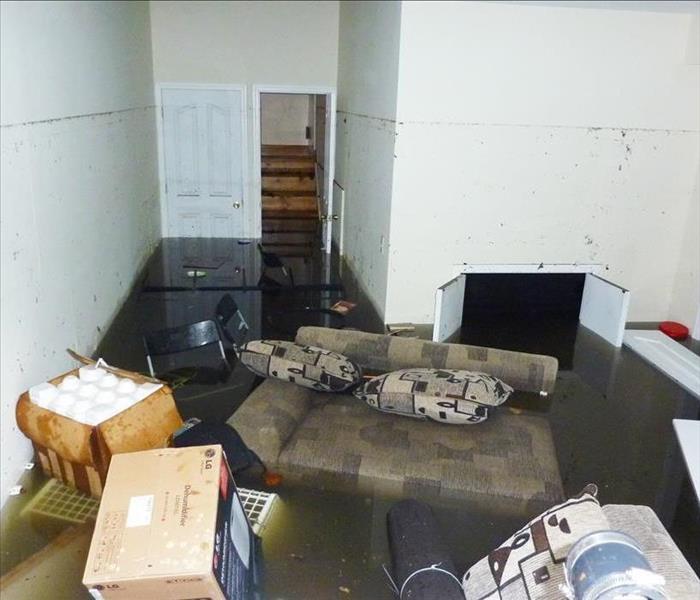 Flooded basement in Liberty, MO
Flooded basement in Liberty, MO
Your basement has suffered severe flooding and you have no idea how it happened. Everything remains underwater and the mess must be cleaned, but you don’t know where to begin. Remain calm and read on.
What Causes a Basement Flood?
There are a few possibilities for why your lower level now resembles an indoor pool, among them:
- Incorrectly installed tiles
- Inadequate sealing
- Overflowing gutters
- Improperly installed downspouts
Structural faults like these can be avoided through proper maintenance. Feel free to conduct your own repairs, but hire a professional if you ever feel unsure.
Another major complication that commonly results in basement flooding is faulty plumbing. Have a pipe repair expert tackle the matter before concerns develop.
Unfortunately, even the best efforts sometimes fail to prevent disaster. Learn the proper response after a catastrophe occurs.
What Should You Do After a Basement Flood?
Before calling upon a water restoration authority, contact your insurance provider to check your coverage and then file a claim if appropriate.
Shut down power to prevent the danger of electric shock. A qualified electrician can help if you are unable to safely reach the circuit breaker.
Wear protection before entering the affected area. Keep in mind that mold grows after dampness sets in. Rubber gloves, waterproof boots and facemasks are highly recommended for safety.
Use a sump pump to evacuate as much water as possible. Run fans to speed up the drying process and deploy a dehumidifier to discourage harmful fungus from taking hold.
Remove anything soaked, including drywall and insulation. Even carpeting may need to be excised. Clean the walls and floor, along with any other exposed surface. As a final step, install waterproofing measures in case the experience ever repeats.
Specific reasons exist as to why flooding may affect your home in Liberty, MO. Take preventive measures to halt them from precipitating severe disruption. Should your worst nightmare happen anyway, following the above recommendations can help restore everything back to normal.
3 Ways To Reduce Your Commercial Building's Water Consumption
8/31/2020 (Permalink)
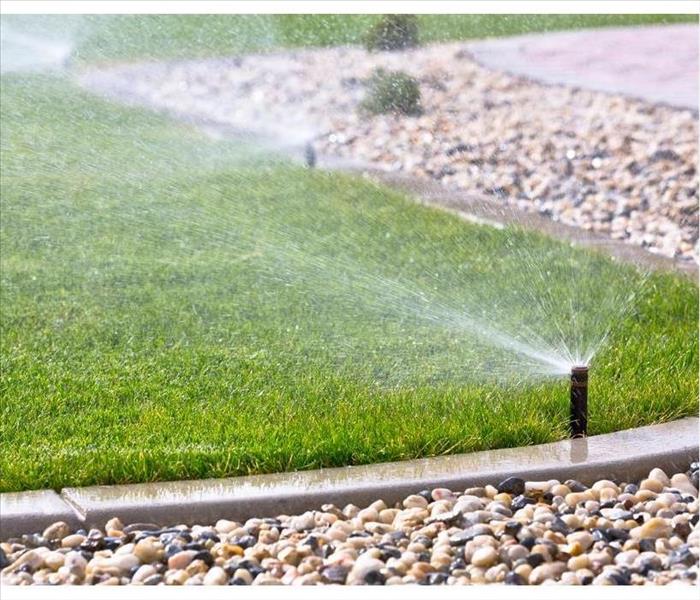 Inspect your irrigation system
Inspect your irrigation system
Methods To Improve Your Property's Water Use And Save Money
Water is an important resource to your Gladstone, MO, business, but it can also create problems when used incorrectly. One of the many water issues you may encounter involves excessive consumption. Your building may use its water inefficiently, which leads to potential problems like property damage and increased costs. Explore the following methods to improve your property's water use and save money.
1. Inspect Your Irrigation System
If you have plant life throughout the commercial building, you likely use an irrigation system to keep it hydrated during hot and dry weather. However, parts of this system can fail and create issues. Malfunctioning devices may irrigate sidewalks and driveways instead of plants and grass. They can also leak and damage the structure, which requires you to call water damage repair specialists. Inspect the irrigation system regularly to ensure correct water consumption and prevent future damage.
2. Control Water Pressure
High pressure in your building's pipes, usually caused by boost pumps, can cause numerous water issues. You may use these devices to improve pressure on the top floors of the building. Unfortunately, this also places extra pressure on the other pipes, wearing them down and potentially leading to leaks and destroyed fixtures. Conserve water and avoid these damages by installing a water upgrade, such as speed pumps and regular valves to maintain the pressure between 60 to 80 psi.
3. Add Native Plants to the Landscape
A healthy landscape within your establishment has numerous benefits, from attracting potential customers to improving property values. You may be tempted to integrate exotic plant life to increase the location's appeal. However, these plants require far more water and last less in this territory than native options. Reduce water and landscaping bills by substituting them with more resistant and less intensive plants.
While your commercial building will consume plenty of water, there are steps you can take to conserve as much water as possible. These measures will help you eliminate water issues and improve efficiency.
What Homeowners Should Know About Water Damage Claims
8/26/2020 (Permalink)
Whether caused by bursting pipes or a natural disaster, water damage can cause major destruction to homes in Kansas City, MO. However, many homeowners have questions about making a claim, and learning more about the process before a disaster occurs can help to put homeowners’ minds at ease.
What Are Common Causes of This Type of Damage?
There are various reasons homes may become flooded. Common sources of flood damage include:
- Toilet overflows
- Burst or leaky pipes
- Flooding as a result of natural disasters
- Roof leaks
What Will Your Policy Cover?
Though individual insurance policies vary in coverage, most home insurance policies will cover the costs of flood damage that occurs accidentally or suddenly. For example, the majority of policies are likely to cover the costs of flood damage that was caused by bursting pipes or a natural disaster. However, coverage often varies when it comes to secondary damage that occurs after a flood, such as mold growth or deteriorating building materials. Additionally, damage that slowly occurs over time, such as leaking pipes, may not be covered.
What Happens After You File a Claim?
Once you know what costs will and will not be covered, the restoration process can begin. Often, it is helpful to contact experts in flood damage restoration. Professionals will first fix the broken pipe, leaky roof or any other issue that has caused the flooding. Then, efforts to prevent mold growth and the deterioration of building materials will begin. Once all water has been removed from the home and the area affected is dry and clean, the home will finally be restored.
Though flooding from bursting pipes and other sources can’t always be prevented, it’s often useful to learn about what your insurance policy is likely to cover in the event of a disaster. Knowing what coverage your policy will provide can help you better prepare yourself and your home for water damage.
Residential Broken Water Heaters Can Leave Lasting Damage
5/26/2020 (Permalink)
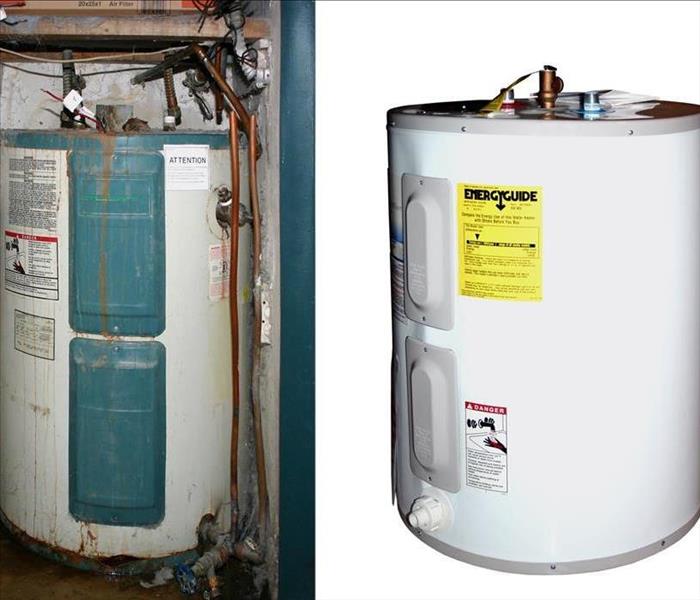 A broken water heater often starts with a small leak
A broken water heater often starts with a small leak
It can be easy to forget that those hot showers are made possible by an appliance. It quickly comes to mind if your home in Kansas City, MO, has a leaking water heater. All that water can quickly lead to damage that may require a water and mold remediation and restoration expert if left unchecked.
Signs of Trouble
While in some cases you may stumble across an unwanted pool of water, a broken water heater often starts with a small leak that can quickly go unnoticed unless inspecting the appliance. There are some subtle clues to look out for that may indicate you have a failed water heater.
- The temperature of the hot water has become cooler.
- Rust residue is found coming out of faucets.
- Cracking or popping noises are heard when the heater is running.
- Hot water begins to have a slightly metallic taste.
- The water heater has visible rust at its base.
Cleanup After a Leak
After discovering a leaking water heater, quick action is required to avoid water damage from spreading. Take the following steps to mitigate water damage.
Turn off the water supply to the heater and remove water remaining in the water heater. Be sure to turn off the gas line heating the water.
Begin removing water from the floor. Since this is considered relatively clean water, it can be cleaned up without worrying about harmful contaminants. Direct the water toward the floor drain if the area is unfinished or use a wet vacuum to suck up the water.
Dry out the area. This may include opening windows, as well as using a fan and dehumidifier. Take humidity levels into consideration before opening windows.
Call the experts. After the area is clean and dry, there could be hidden damage or water. Getting a professional inspection can help you avoid secondary water damage.
While a leaking water heater may not happen frequently, it is an appliance that can cause damage if not operating properly. Quick action and regular inspections can keep those showers hot and carefree.
Understanding Secondary Damage
5/11/2020 (Permalink)
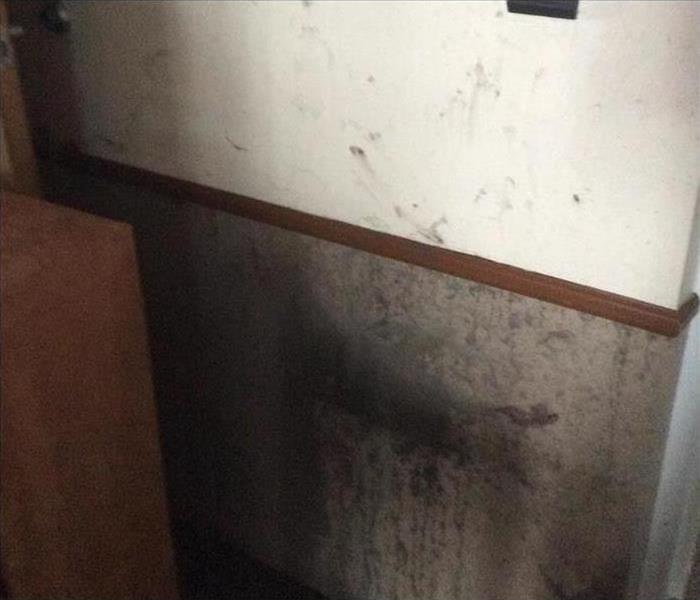 Mold growth as the result of secondary damage in Gladstone, MO
Mold growth as the result of secondary damage in Gladstone, MO
Any time your business in Gladstone, MO, experiences a disaster, it's crucial to have experts on board during the cleanup phase to assess the best possible solutions to avoid future risk. If a water disaster isn't cleaned and dried properly, you risk secondary damage such as black mold.
The Risk of Secondary Damage
Secondary damage is damage that results from the initial damage. If the initial damage, such as a flooded restroom, is attended to correctly, and damaged materials are replaced, all flooring and cracks in flooring are properly dried, and all contaminants are disinfected or removed, you won't have secondary damage.
It's important to understand that an untrained professional will not have the skills or knowledge to successfully prevent secondary damage. Always hire a certified cleanup and restoration specialist to handle disasters of any size.
Black mold is one of the most common examples of secondary damage. Because black mold can grow behind walls, in ceilings, and under flooring where it can't be seen, it can cause damage for a lengthy period of time before it is found. Black mold grows as a result of materials that remained wet due to high humidity or improper drying techniques.
Preventing Secondary Damage
Prevention measures for secondary damage include using special chemicals, drying techniques, and testing equipment that specialists have been trained to use. When you hire a cleanup specialist, look for the IICRC certification on their web page or advertising. If you don't see it, ask. If the person you hire isn't properly trained, you increase your risk of experiencing secondary damage.
The best way to avoid secondary damage is to call your clean up and restoration professional immediately after the damage has occurred. Secondary damage such as black mold can be as dangerous as the primary damage. The sooner your disaster is cleaned, the fewer material losses you will have.
Home Basement Flooding: Will Your Insurance Pay?
2/14/2020 (Permalink)
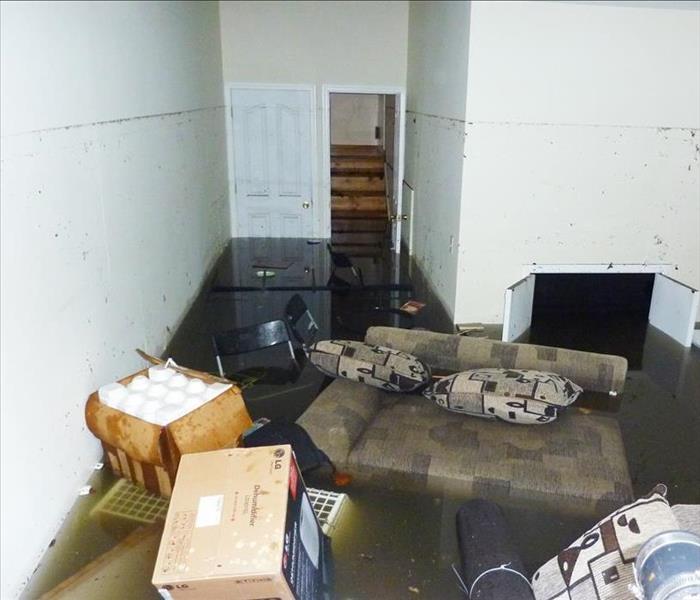 Flooded basement in Kansas City, MO
Flooded basement in Kansas City, MO
Basement flooding is among the top reasons for homeowner’s insurance claims. If you’ve discovered a basement flood in your Kansas City, MO, home, you suddenly have a long list of tasks to take care of to protect your property. It may help to understand whether you can expect insurance to pay for your damages.
Water damage is handled through two separate insurance sectors, depending on the source of the water. Many common causes of home flooding fall under the umbrella of your homeowner’s insurance, but there are exceptions.
Homeowner’s Insurance and Water Damage
Your conventional insurance will generally cover a portion of the water cleanup and restoration costs for a basement flood, as long as the water didn’t enter from outside the home, such as with rising floodwaters. These are among the scenarios that would likely be covered:
- Broken or leaking water pipe
- Leaking appliances, such as a washing machine or ice maker
- Stormwater leaking through a damaged roof
- Overflowing toilet
- Overflowing bathtub or shower
It’s important to report the damage with your insurance agent right away if your basement has flooded. If your damage was caused by external water entering your home, you will need to look beyond your conventional policy.
Government Flood Insurance
A flood is defined as a temporary condition where usually dry land is inundated with water or mud. If your basement flood was caused by floodwater entering your home from ground level or below, a special government flood insurance policy would be required for coverage. Flood insurance is issued by the US Government, but your agent can help you purchase it or file a claim. If you are considering flood insurance, it may be useful to determine your level of flood risk. Your agent can refer you to an expert who can help assess your risk.
Researching insurance coverage options and finding out your flood risk level are important steps in food preparedness. If you experience water damage, it's a stressful time, and knowing which insurance entity to approach will move you one step closer to returning your home and your peace of mind to normalcy.
4 Steps for Using a Drain Snake
12/13/2019 (Permalink)
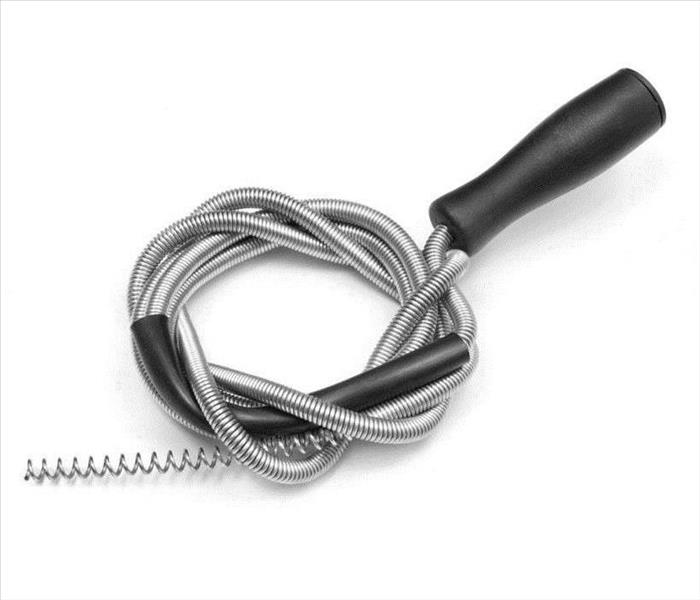 Using a drain snake is a simple way to fix a clogged pipe
Using a drain snake is a simple way to fix a clogged pipe
Knowing How To Use a Drain Snake
Plumbing issues can cause a big disruption in your daily routine. When you have a clogged drain in your home in Gladstone, MO, it can lead to leaks and overflows that cause significant water damage. Addressing the issue as soon as it occurs is a good way to avoid bigger problems and the costly repairs that go with them. Knowing how to use a drain snake helps you get rid of the clog in four easy steps.
1. Position the Snake
When you pick up the drain snake (otherwise known as an auger), you may notice that it has a coiled portion. This is the part that is going to extend into your drain to combat the clog. To release it, remove any stopper on your drain and push the end of the auger into the opening created. Once you start turning the crank, it will drive the coil into the drain.
2. Apply Pressure
You must apply pressure to get the snake to traverse the bends in your pipe and reach the clogged portion. Many homeowners are afraid that they will cause a pipe break if they push too hard, but water restoration specialists advise that this is unlikely to happen.
3. Break the Clog
Once the end of the snake reaches the stopped up area, you may feel resistance. Continue cranking the handle to break up the clog. If a solid object is obstructing your pipe, the drain snake can trap it so that you are able to pull it out.
4. Flood With Water
When you think you have released the clog, whether by breaking up the particles or pulling them out of the drain, try running your water at full blast. If the water drains easily, you know you have resolved the issue. If it doesn't, you may try snaking the drain a second time.
Using a drain snake is a simple way to fix a clogged pipe. By following a few simple steps, you can avoid potential water damage.
Is Crawl Space Water a Problem?
10/30/2019 (Permalink)
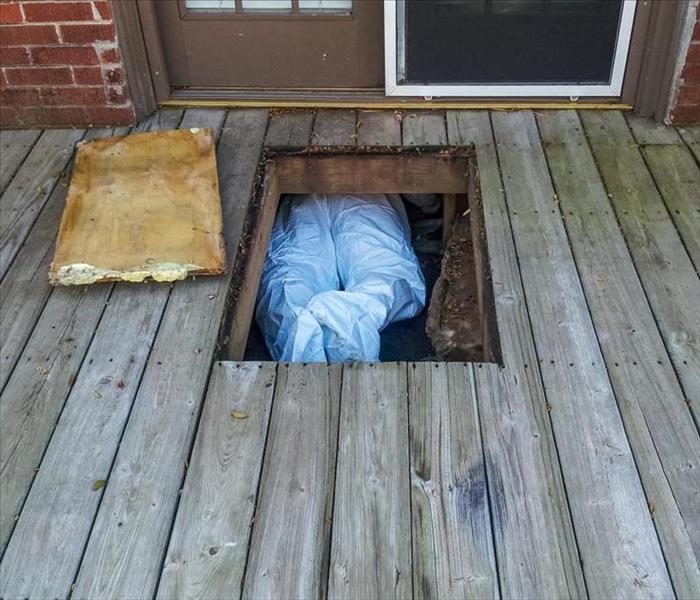 As a Liberty, MO, homeowner, finding water in your crawl space can be unsettling
As a Liberty, MO, homeowner, finding water in your crawl space can be unsettling
As a Liberty, MO, homeowner, finding water in your crawl space can be unsettling; it could be an ominous sign that there are bigger issues that have gone unnoticed. Now you have at least two challenges on your hands: getting rid of the water in your crawl space and finding the source of that water. A wet crawl space can cause your home a variety of problems and must be dealt with immediately.
What Are the Causes?
There are a number of reasons why water may collect under your house. Furthermore, it’s usually a sign that something else is going on. It’s recommended that dehumidification professionals are hired to assess the situation. They’ll check for the following:
- Cracks in the foundation or walls
- Improper grading or slope of the property
- Failing or improperly installed gutters or downspouts
- Broken water lines
These are only a few common causes of a wet crawl space. The problem can range from a noticeable increase in humidity resulting in condensation to a full-blown flood. Either way, there’s no time to waste, as things can quickly get out of control.
What Are the Risks?
As minor as a little water in your crawl space may seem, major problems can develop that can affect your whole house, one of the worst being mold. There’s a good possibility that your HVAC system and ductwork are located in your crawl space. Once mold develops down there, the spores can travel into the air ducts and throughout your home, growing mold in places where you’re likely to not even notice.
Another risk of the humidity under your house is moist wood. This is an ideal situation for termites, as well as other pests such as rodents, roaches and spiders.
Depending on the cause of your wet crawl space, there are a variety of options for remedying the situation. These solutions include installing a sump pump if the area is prone to flooding, installing a crawl space dehumidifier or installing a vapor barrier on the floor and walls. Take action immediately to get your home assessed before any more damage develops.
Steps To Take After a Toilet Overflows
8/27/2019 (Permalink)
 Toilet overflow in a Gladstone, MO home
Toilet overflow in a Gladstone, MO home
Here is What To Do If Your Toilet Overflows
A toilet that overflows unexpectedly one is probably a fluke and nothing to worry about. However, if you find that your flooded toilet is becoming a problem more often than not, you could be dealing with sewer damage in Gladstone, MO. Here's what to do if you keep having problems.
Stop the Flow of Water
The first thing to do for a flooded toilet is to stop the flow of water. The best way to do this is to remove the lid of the toilet tank and complete the following steps:
- Push down the rubber valve
- Lift the float at the same time
- Have someone turn off the water valve
The final step is easier to do if you have a second person with you but must be done regardless, even if it means a bit of extra water at first.
Begin the Cleanup Process
If the mess from the clogged toilet is a mild one, you can begin the cleanup process yourself before calling someone to check for sewer damage. First, you'll need to mop up the dirty toilet water. Do this as soon as you stop the flow of water and get as much as you can into a bucket. If you suspect the problem is a toy or other type of clog in the bowl, use a plunger to unclog it. However, if the problem seems more severe, you'll need to call a professional.
Hire a Professional
Sometimes, a clogged toilet is actually a symptom of damage to your sewer lines. If the backup occurs frequently or doesn't seem to stop, you'll need to contact a sewage company. These professionals have the knowledge, tools, and experience to salvage as much as possible in your bathroom and begin the repair process.
When hiring sewer damage professionals, search for companies that are licensed and insured. Finding the best company for the job further ensures the safety of your home and property.
What to do with water damage in home?
5/28/2019 (Permalink)
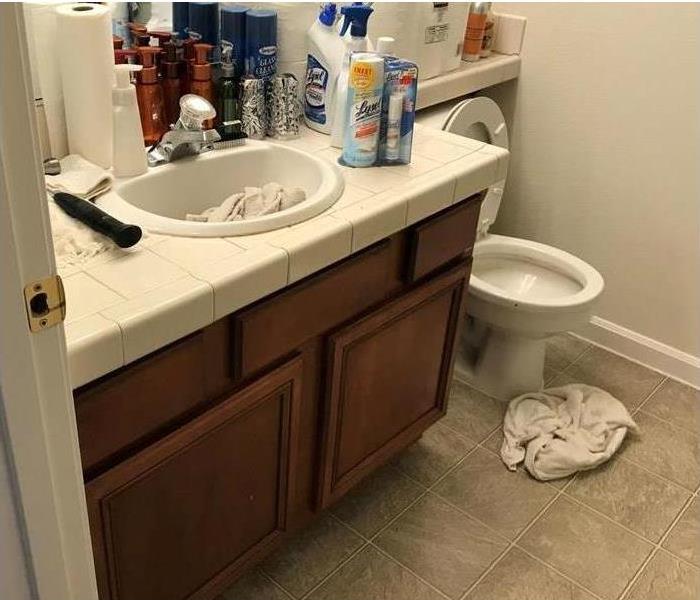 Water damage in a bathroom.
Water damage in a bathroom.
Steps to follow when our home has water damage
If you have water damage in your home it is important to make sure that you have it removed as soon as possible. If the water sits for several days, it can cause secondary damage like mold and other types of microbial growth.
It is important to call SERVPRO of Clay County as soon as possible, to come on site and begin the water removal process. Our team is available 24 hours a day to remove water in your home.
Once the water is removed, SERVPRO can begin to place air movers and dehumidifiers in the house. After a few days of drying and monitoring, the equipment can be removed once the drying is complete.
If you have any questions about what to do with water damage in your home, feel free to contact us at anytime, (816) 436-7420.
Water Damage in Clay County
4/30/2019 (Permalink)
 Pipe Bursts can be a leading cause for Water Damage in your home.
Pipe Bursts can be a leading cause for Water Damage in your home.
What to Do if your Pipe Bursts
If you are unfortunate enough to have a burst pipe, follow these steps:
- Turn off your water supply at the main valve. Your main water valve can be located in a variety of places. If you have a home with a basement or crawlspace, it is probably located on an interior wall near the front of the house. In this case, it is most likely hiding in plain sight. If your home was built on a slab, the valve might be located near the hot water heater or inside your garage. It may also be located in an underground cement box near your front curb. To learn where your main water valve is, consult you property inspection report or call your local utility company or plumbing professional. Learn more tips for locating your main water valve here. If the burst pipe is a hot water line, make sure to also turn off the water valve at the top of your hot water heater.
- Once you have turned off the main water valve, call a plumber.
- If your water meter is frozen, contact your local Water Department.
If your broken pipe has caused water damage to your home or business, call SERVPRO of Clay County to dry it out before it ruins materials and they need to be torn out.
3 Ways To Conserve Water in Your Commercial Building
4/17/2019 (Permalink)
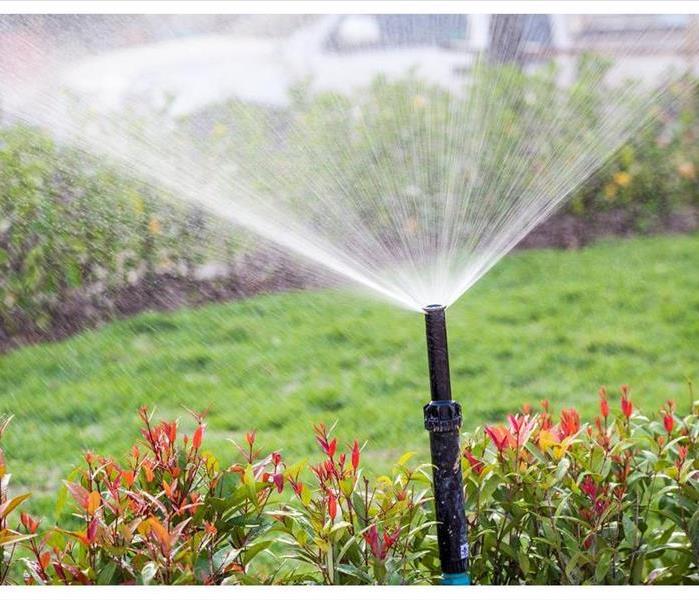 By implementing a sensible irrigation plan, you can maximize its effectiveness and probably save money on water bill and water remediation services.
By implementing a sensible irrigation plan, you can maximize its effectiveness and probably save money on water bill and water remediation services.
Techniques For Conserving Water At Your Place Of Business.
Owning a business comes with many expenses, and they are often not negotiable. Tackling your water issues, however, can be a boost to your budget. Rather than pouring your money down the drain every month, try some of these techniques for conserving water at your place of business.
1. Appliance Upgrades
One of the easiest ways to use less water is to invest in a water upgrade whenever possible. Some upgrades include:
• Low-flow toilets
• Touch-operated sinks
• Energy efficient appliances
You may be amazed at how much money you can save on your water bill in Gladstone, MO, just by switching to appliances that use less water. The main benefit of this strategy is that you don’t really need employee cooperation to make it work. The upgrades do the work for you.
2. Meter Separation
A general reading from your water meter only tells you your overall water use. To analyze your water issues to see where you need to cut back, you need to submeter usages such as your irrigation system and cooling tower. Once you separate those readings from the rest of your usage, you can better assess where you are using the most water and which of your conservation strategies are working the best.
3. Irrigation Planning
You may notice that your water sprinklers are getting the sidewalk just as wet as the lawn. Maybe your automated sprinklers turn on in the heat of the day, even in summer. Perhaps your drainage system causes water to pool near your foundation where it can cause water damage rather than distributing water to the vegetation where it’s needed. By implementing a sensible irrigation plan, you can maximize its effectiveness and probably save money on both the water bill and water remediation services at the same time.
Conserving water starts with assessing your water issues. With a little bit of planning and a few upgrades, you may be able to drastically reduce your water bill.
Pipe Problems In Home
1/23/2019 (Permalink)
 Clogged drain in a Gladstone, MO home
Clogged drain in a Gladstone, MO home
Learn How to Manage Flooding Caused by Bursting Pipes
A well-maintained residence in Gladstone, MO, can still have a few issues with its plumbing system. Learn how to manage flooding caused by bursting pipes with the following how-to suggestions.
1. Inspection
The easiest way to prevent plumbing problems is to routinely inspect your pipes and appliances for leaks. This is especially true of homes with older plumbing made of copper or certain plastics no longer in common use. While such materials are not in need of immediate replacement, they can create an additional risk of damage due to corrosion or cracking, especially at junctures and connection points. Make time to fix broken pipe segments as soon as you notice the damage.
2. Drainage
Clogged drains can present another point of failure for a plumbing system. If you notice water backing up in the basin of your sink or tub, or you hear any unusual noises as water moves through your pipes, you may have some sort of blockage. If left untreated, these clogs can contribute to bursting pipes in your plumbing. While caustic drain cleaners can be effective, they are not the only option. Use mechanical drain snakes or enzymatic clog removers if possible, to preserve the integrity of your plumbing system.
3. Recovery
Sometimes flooding and other water damage can occur regardless of the diligence of the home owner. In these cases, you should take steps to prevent any ongoing damage from water retention by safely draining the water from the premises. Cut all power to the affected area, as this can present a safety hazard. Remove any sensitive documents or electronics. Your home insurance policy likely covers the costs necessary to hire a qualified flood damage restoration service, so contact your provider as soon as possible.
While a home flood due to bursting pipes and other plumbing maladies can be an unfortunate disruption, there are a number of steps you can take to reduce the risk of damage and begin the restoration process quickly.
4 Sewage Damage Cleaning Steps
12/26/2018 (Permalink)
 Sewage backup is contaminated with biological viruses and bacteria
Sewage backup is contaminated with biological viruses and bacteria
Sewer Cleanup Process
A sewer backup calls for thorough cleaning and disinfection. Sewage overflow and Category Three black water contain bacteria and other microbes that may pose a heightened risk of infection or mold growth. Follow these four steps or hire a damage mitigation service to complete the sewer cleanup process.
1. Remove Water and Solids
A homeowner or cleanup service should use equipment such as a mop or wet vac to remove liquid and solids. Take this step as soon as possible after a backup occurs. Keep in mind that the problem will recur until the clog in the drain line is cleared.
2. Tear Out Porous Contents and Materials
Porous materials such as drywall or contents such as carpet cannot be completely cleaned after exposure to Category Three black water. It is possible to do a preliminary disinfection of the area prior to tearing out these materials and contents. Homeowners should wait for the affected area to dry before proceeding with restoration.
3. Clean and Disinfect the Area
In addition to sewer cleanup, it will also be necessary to disinfect the area exposed to black water. A preliminary disinfection should be followed up by a thorough cleaning and disinfection after all damaged porous materials have been removed. Otherwise, the tearing out process can lead to recontamination.
4. Dry the Area
The affected area should be allowed to dry completely before restoring drywall, carpet, or other contents. Professionals may recommend the use of fans or dehumidifiers to speed up the process. Any residual moisture will increase the likelihood of mold growth.
Every one of these steps is necessary to clean up a sewer backup at a residence in Kansas City, MO. Whether the damage is due to a flooded toilet or a backed up city main, sewer cleanup specialists have the expertise and equipment necessary to address primary damage and prevent secondary damage.
How Do You Identify Secondary Damage?
6/20/2018 (Permalink)
Flooding in Kansas City, MO can be hard enough to deal with without considering the effects of secondary damage. Secondary damage is what happens less as a direct result of the impact of flood waters and more as a side effect of the presence of the water itself. Common issues include black mold and mildew. So how do you recognize the difference between primary damage and secondary damage?
Know What Primary Damage Is.
Primary damage includes the effects of floodwater on your property, including:
• Impact damage from high-pressure flooding or high-speed floodwaters
• Erosion of soil on your property
• Ruined and waterlogged items
• Structural damage
These are all direct effects of flooding. Secondary damage can happen when the initial damage of flooding isn’t mitigated quickly enough – which is where black mold comes in.
Recognizing Secondary Damage.
Areas waterlogged by flooding or suffering from high humidity after a flood even are at high risk of a black mold infestation. Black mold is a pervasive fungus that permeates your environment in the form of spores. When too much standing water is left after a flood or if waterlogged items are left unattended, this can encourage the development of mold. You may have mold if you:
• Smell foul, musty odors in the air
• Notice developing spots of black, green, white, yellow, or brown fuzz on your furniture or appliances
However, mold can also be a hidden problem. After flooding it’s usually a good idea to work with a mold remediation specialist. Mold remediation specialists are usually highly trained environmental hygienists capable of finding mold wherever it’s hiding, including inside your walls and underneath your appliances.
After a flood, it’s not enough to just dry out your home, repair any structural damage, and replace damaged possessions. You must be absolutely vigilant to prevent secondary damage such as mold from taking root and causing potential catastrophic damage to your home.
For more information, please visit us at http://www.SERVPROclaycounty.com/.
Use a Professional Water Restoration Company
5/29/2018 (Permalink)
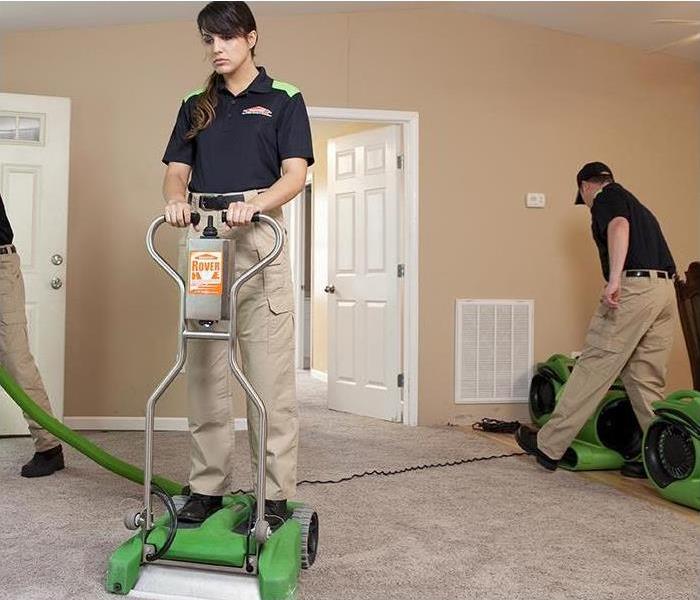 Cleaning a water damage in Clay County
Cleaning a water damage in Clay County
You come home from vacation and find a flood of water in your finished basement.
Who can you call to help you? You may think of calling a contractor, but there are differences between contractors and professional Water Restoration Companies. As a professional Restoration Company, we try to restore, rather than replace, whenever possible.
A contractor’s job is to replace everything that is affected. This will often include all flooring, walls, cabinets and even furniture. SERVPRO of Clay County technicians are certified in drying and cleaning water damage to industry standards. We will not remove materials unless it is necessary. The average time to dry is 3 days. This prevents further interruption to your daily life and also saves you money. We try to mitigate the water damage, and restore when possible. Restoring your home is a less expensive than replacing materials in your home.
Call SERVPRO of Clay County. We are available 24/7 for emergency water losses.
How to detect water in home?
5/4/2018 (Permalink)
If you think you have water in your home, you might not be able to see it but it could require that you have a professional restoration company like SERVPRO come on site and do an evaluation.
SERVPRO has many different tools and resources that can detect water that is unseen to the eyes. One way is using a thermal camera that can determine temperature variations in the wall and other porous surfaces.
Once the damaged area is detected, SERVPRO can begin to remove damaged materials and extract any standing water. After that they can place equipment to dry until all of the moisture meters measure the home as dry.
SERVPRO operates 24 hours a day, 7 days a week. If you ever have any questions, feel free to reach out at anytime.
How to prevent water damage in your home?
5/4/2018 (Permalink)
If you have ever had a water loss in your home, you understand that it can be a very stressful time. SERVPRO of Clay County wanted to provide some information that you can use to help prevent water losses in your home for the future. However as a disclaimer these are simply to be the best prepared but no practice can prevent unexpected and accidental water losses.
1. The first thing we always recommend is to understand where all of you emergency shut off valves are in your home. If there is a water loss from a busted pipe, you can cut the water off that will minimize the amount of damage.
2. Know your emergency contact numbers. Make sure you have a plumber, electrician and a disaster restoration company like SERVPRO of Clay County in your mobile phone.
Overall it is important to have resources and contacts documented and reviewed throughout the year. Being prepared can help minimize and prevent future water losses.
Look Who's in the News for Water Damage Cleanup!
8/31/2016 (Permalink)
Our franchise is in the news! We are helping clean up water damage and flooded basements after these heavy storms. Check it out!
http://www.kmbc.com/news/crews-help-homeowners-with-flooded-basements-after-storms/41424038
Kansas City Area Residents: We Specialize in Flooded Basement Cleanup and Restoration!
3/28/2016 (Permalink)
A basement can flood at any time, although flooding most often occurs during heavy rainfall. Basements are inherently prone to flooding because they are the lowest level of a building and are normally built partly or entirely below ground level. There are a number of reasons why your basement could flood, including:
- · A blocked or failed sewer lateral pipe
- · Heavy rain causes surface water to pool around your home
- · Storm sewer backup
- · Sanitary sewer backup
- · Foundation drainage failure
- · Water supply-line break or hot-water tank failure
- · And many more
Last year there were many flooded basement due to heavy rains and overflowing creeks and rivers.
If You Have Questions or Need Help, Please Call Us at
913-381-6550 or 816-436-7420
We use advanced inspection and monitoring equipment such as infrared cameras and moisture meters to determine if your home’s structure is actually dry. Touch is not a reliable method, as moisture can trap inside.
If Water Damage is not handled quickly and properly, it can cause severe damage to your home’s structure, not to mention the potential harmful health effects of mold. Remember, the longer you wait, the worse the problem will get.
We are Flooded Basement Specialists:
- We are available 24 hours/7 days per week for emergencies.
- We’re a Preferred Vendor to many national insurance companies
- We bill your insurance directly – one less thing for you to worry about
- Our Technicians are highly-trained in Water Restoration Techniques
- We use s500 IICRC Restoration Standards
- Advanced inspection and extraction equipment
Basement Flooded? Call Us Today – We’re Here To Help - 913-381-6550 or 816-436-7420




 24/7 Emergency Service
24/7 Emergency Service























